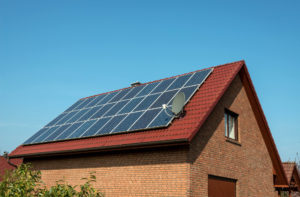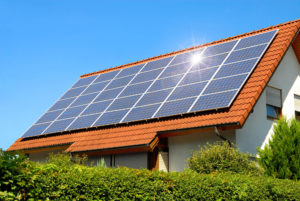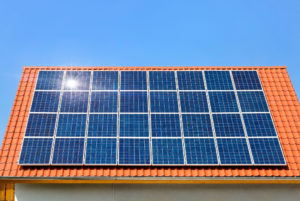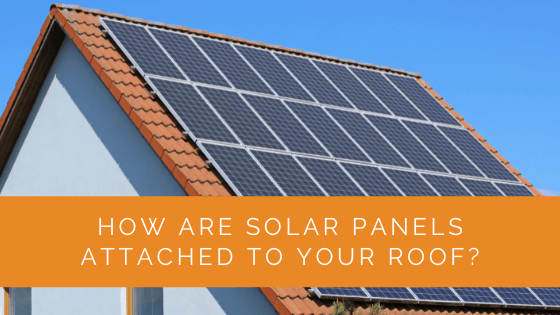Harnessing solar energy has become an increasingly popular and sustainable solution for homeowners looking to reduce their carbon footprint and energy bills. However, many are left wondering about the specifics of solar panel installation, particularly how these panels are securely attached to various types of roofs. This article delves into the intricacies of solar panel installation across different roof materials, offering a comprehensive guide that covers everything from the state of your roof, house location, and roof strength to the specific installation processes for standing seam metal roofs, tile roofs, and corrugated metal roofs. Whether you’re a DIY enthusiast or planning to hire professionals, understanding these factors is crucial for a successful and long-lasting solar panel installation.
Contents
- 1 Key Takeaways
- 2 Solar Panel Installation for Varied Roof Types
- 3 8-Step Process to Installing Solar Panels
- 4 Connecting Solar Panels to the Inverter
- 5 Different Types of Solar Mounting Systems for Roof
- 6 Case Study: Residential Solar Panel Installation
- 7 Expert Insights From Our Solar Panel Installers About How Solar Panels Are Attached to Your Roof
- 8 Experience Solar Excellence with Us!
- 9 The Bottom Line
Key Takeaways
- Solar panels can be attached to various types of roofs, including standing seam metal roofs, tile roofs, and corrugated metal roofs. The installation process varies depending on the roof type.
- Proper assessment of your roof’s condition, its location, and its strength is essential before installing solar panels to ensure efficient energy production and structural integrity.
- The installation of solar panels involves several steps, including collecting materials, setting up stanchions, installing flashing, securing rails, checking for alignment, attaching wiring, mounting panels, and connecting panels to the inverter. Proper electrical work and safety precautions are also crucial during installation.
Solar Panel Installation for Varied Roof Types
With consistent developments in the solar power industry, you can now install solar panels on all kinds of roof materials. You can quickly secure solar panels on any old or new roof with the help of mounting systems. However, you need to consider the following factors before deciding to proceed with installing a solar system.
State of Your Roof
If you plan to get a new roof structure, you will have to remove the solar panels and reinstall them. Therefore, it is better to get your roof checked before installing the solar panels.
House Location
For solar panels to work efficiently, you need to ensure that the roof receives the most sunlight during the day. You should ensure that no trees or buildings obstruct your solar systems’ primary source of energy.
Roof Strength
Even though solar panels aren’t overly heavy, they can still add about 2.7 pounds per square foot. So, you should check in with a structural engineer before planning to install solar panels.
Standing Seam Metal Roofs
Standing seam metal roofs are the easiest roof type to install solar panels. Here, you do not require to proceed with drilling holes through the roof. The raised seam on the roof surface helps attach the solar array with the help of a U clamp.
A standing seam metal roof is ideal for installing solar panels as the raised seam leaves plenty of space for air to circulate beneath solar arrays.

Tile Roof
The tile roof surface is one of the most aesthetic and durable roof types. It also helps you save money in the long run as tiles are installed individually instead of overlapping sheets. But tile roofs can be a nightmare when it comes to installing panels.
Here, you need to begin by removing a few tiles. Then, steel brackets are attached to the roof’s rafters, and tiles are reinstalled. The railing system is laid on the brackets, and solar panels are attached. It also allows for some gap between the tile roof and one rail for air circulation.
While you might want to complete the process yourself, it is advised to contact a solar installer. Professionals will ensure minimal damage and ensure that the upper and lower rails are sturdy enough to hold solar panels.
Corrugated Metal Roofs
If your metal roof isn’t standing seam, you can install solar panels on the surface a bit differently. The solar panel mounting system is attached to brackets called straddle blocks using galvanized screws.
The process requires you to drill holes in the roof surface first. Then, the racking system is attached safely to the top ridge.
Straddle blocks are beneficial if your metal roof is uneven or has gaps between the panel.
8-Step Process to Installing Solar Panels
Solar panels experience a lot of natural disasters and rough weather conditions. Therefore, you need to ensure that the panels are tightly secured to the roof and won’t come loose in the upcoming years. Follow these steps to understand the installation process.
Collect All the Material
Once you are up on the roof, there’s no point returning down repeatedly for any tool. Standard essentials include a tape measure, chalk line, pencil, and drill.
Prop the Stanchions
To get maximum exposure to solar energy, the structure should be at a tilt of nearly 18 degrees. Spot your roof’s rafters and attach stanchions to them using screws. Ideally, stanchions should have at least 4 feet of gap between them.

Install the Flashing
You can do that by removing the shingles and then attaching flashing to the roof’s rafter. Flashing is necessary to seal the roof post drilling and ensure no water flow inside.
Set the Rails up
Stick the screws in the holes and secure them nicely. Now, connect stanchions to the lower and upper rail using bolts. You can use an impact driver to ensure maximum tightness.
Check if the Rails are Parallel
Take a measuring tape and check the diagonal distance between the ends of both rails. If the value is uneven, make the adjustments accordingly.
Fix the Middle Rail
Place the middle rail so that it aligns with the upper and lower rails.
Attach Wiring
In your solar panel package, you will find power inverter kits. Place a power inverter kit beneath each of the panels with copper wires. The connection will run in and out of the solar array in an ideal situation.
Run wire connections between the panel and the electrical meter, and finally to an electrical sub panel. Each rail has a trunk through which the wire should pass to connect to an inverter.
Mounts the Panels
Fix the solar panels to the stanchions and check if the plug connections are secured. Now, attach the retaining clips to the rails.
Connecting Solar Panels to the Inverter
Once you are done with the installation, it is time to focus on the electrical work. Before starting, switch off the power supply to avoid any mishaps. You need to connect your solar system to the inverter to convert the solar power stored from DC to AC. Alternating current is compatible with most household appliances.
Ensure that the inverter is not stored in a hot environment. If you are placing it outside, put it in the shade. Now, connect your inverter to the battery.
Battery stores all the solar energy that is not used and dispatches it later when the sun is not shining. Finally, connect the inverter to the consumer unit to ensure protection in emergency cases.

Different Types of Solar Mounting Systems for Roof
The mounting system helps connect the solar panels to the roof surface. Here are a few types of roof-mounted solar systems.
Sloped Roof Mounting System
Sloped roofs are prevalent in residential set-ups all over the country. For such angled roofs, you will find different kinds of mounting systems. Some standard options include rail-less, shared rail and railed systems.
Flat Roof Mounting Systems
The solar installation process is relatively easy for a flat roof like that on manufacturing units or big box stores. The ballast mount system is made to tilt at an angle between 5 and 15 degrees to get maximum sun exposure.
Solar Shingles
Solar shingles are a form of BIPV (Building-integrated photovoltaics) and are directly attached to the roof structure. Here, there is no panel mounting procedure needed. More people are starting to install solar shingles as they can be made to look like tiles and give an even look to the roof.
Case Study: Residential Solar Panel Installation
Background
At Solar Panels Network USA, we recently undertook a residential solar panel installation project in Austin, Texas. The goal was to help the homeowner reduce their energy bills and carbon footprint by harnessing solar power. This case study outlines our approach, the implementation process, and the results achieved.
Project Overview
The homeowner, living in a suburban area of Austin, wanted to switch to solar energy to leverage the abundant sunlight in Texas. They aimed to reduce their dependence on the grid and take advantage of local solar incentives. The key considerations included the condition of the roof, the optimal placement for maximum sunlight exposure, and ensuring a secure and durable installation.
Implementation
Site Assessment and Preparation
Our team began with a comprehensive site assessment, evaluating the roof’s condition, orientation, and shading. The roof was found to be in good condition, with a south-facing orientation ideal for solar panel installation.
System Design
We designed a solar panel system tailored to the homeowner’s energy needs. The design included:
- High-efficiency photovoltaic panels
- A robust mounting system suitable for the roof type
- An inverter to convert DC to AC power
- Solar batteries for energy storage
Installation Process
- Material Collection: We gathered all necessary materials, including mounting hardware, solar panels, inverters, and wiring.
- Stanchion Setup: Stanchions were attached to the roof rafters at intervals of 4 feet, ensuring a stable base for the solar panels.
- Flashing Installation: Flashing was installed to prevent water ingress, ensuring the roof’s integrity was maintained.
- Rail Attachment: Rails were securely attached to the stanchions, providing a strong framework for the panels.
- Panel Installation: Solar panels were mounted on the rails, ensuring they were securely fixed and optimally aligned for sunlight exposure.
- Wiring and Inverter Connection: We connected the panels to the inverter and integrated the system with the home’s electrical grid.
- Safety Checks: A thorough inspection was conducted to ensure all connections were secure and met safety standards.
Post-Installation Support
We provided the homeowner with detailed instructions on system maintenance and monitored the system’s performance remotely to ensure it operated at peak efficiency.
Results
Environmental Impact
The installation significantly reduced the homeowner’s carbon footprint, with the system generating approximately 6,000 kWh of electricity annually. This reduction in reliance on fossil fuels contributed to a decrease in greenhouse gas emissions.
Energy Savings
The homeowner saw a substantial decrease in their monthly energy bills, with estimated savings of around $1,200 annually. The solar system is expected to pay for itself within 7 years, thanks to local incentives and tax credits.
Enhanced Property Value
Installing the solar panel system increased the home’s market value, making it more attractive to potential buyers in the future.
Summary
This project in Austin, Texas, highlights the benefits of residential solar panel installations. By leveraging local sunlight and utilizing high-efficiency panels, we helped the homeowner achieve significant energy savings and environmental benefits. At Solar Panels Network USA, we are dedicated to providing sustainable energy solutions tailored to our clients’ needs.
Expert Insights From Our Solar Panel Installers About How Solar Panels Are Attached to Your Roof
Properly assessing your roof’s condition and structure is the first critical step. A thorough inspection ensures the roof can support the additional weight and that the installation will be both safe and durable.
Senior Solar Panel Installer
Different roof types require different mounting systems. For instance, standing seam metal roofs use clamps, while tile roofs need brackets. Understanding these differences is key to a successful installation.
Lead Solar Engineer
Safety is paramount when connecting the solar panels to the inverter and the grid. Ensuring all connections are secure and up to code prevents potential hazards and optimizes system efficiency.
Chief Installation Officer
Experience Solar Excellence with Us!
Trust in Solar Panels Network USA, where our seasoned experts deliver top-quality solar solutions for homes and businesses nationwide. With a legacy of countless successful installations and a commitment to sustainable energy, we’re your reliable partner in the solar journey. Ready for a brighter, eco-friendly future? Call us now at (855) 427-0058 and harness the power of the sun!
The Bottom Line
The vast majority of people now embrace solar systems and prefer eco-friendly energy. However, the process of getting solar panels installed is complicated and needs to be performed with utmost care.
For different roof types, the solar industry has provided different mounting systems. Some panels are connected using a lag bolt, while the others might require tile hooks. If you are not sure about your roof type, it is better to contact the installer.
About the Author
Solar Panels Network USA stands at the forefront of solar energy solutions, driven by a team of seasoned solar engineers and energy consultants. With over decades of experience in delivering high-quality solar installations and maintenance, we are committed to promoting sustainable energy through customer-centric, tailored solutions. Our articles reflect this commitment, crafted collaboratively by experts to provide accurate, up-to-date insights into solar technology, ensuring our readers are well-informed and empowered in their solar energy decisions.

